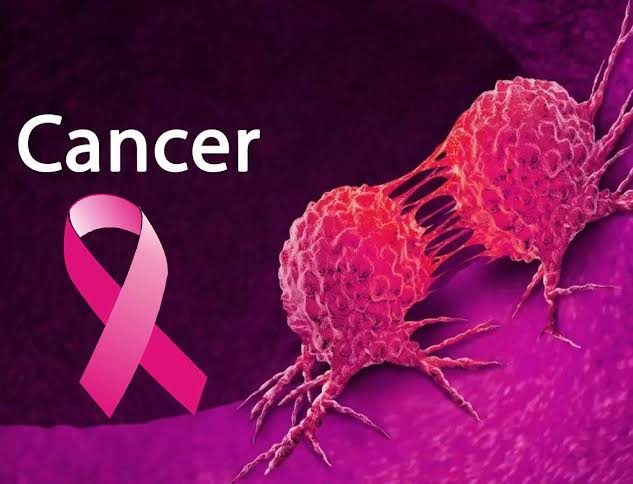By Ojo Folashade
Cancer is a disease in which some of the body’s cells grow uncontrollably and spread to other parts of the body. Cancer can start almost anywhere in the human body, which is made up of trillions of cells.
Cancer is a disease that occurs when cells in the body begin to grow out of control. Normally, cells grow and divide to form new cells, but cancer cells continue to grow and divide even when they shouldn’t. Eventually, these cancer cells can form a mass called a tumour. Not all tumours are cancerous, but tumours can be very dangerous if they’re cancerous because they can spread to other parts of the body.
Read Also
- 10 Important Facts to Know About Anthrax Disease
- How Scent And Bitter Leaf Juice Can be Use to Treat 5 Chronic Disease:
- 5 Early Warning Signs of Heart Attack: Taking action promptly can save lives
Cancer can affect any part of the body. Some of the most common types of cancer include breast cancer, lung cancer, colon cancer, prostate cancer, and skin cancer. There are also many rarer types of cancer, and each type has its own unique characteristics. There are a lot of risk factors for cancer, including age, family history, and lifestyle factors like diet and exercise.
It’s possible for someone to have cancer and not know it. This is especially true for breast cancer, which often has no symptoms in the early stages. That’s why it’s so important for women to get regular mammograms and perform self-exams. If cancer is caught early, it’s much easier to treat.
Latent cancer refers to a type of cancer that’s present in the body but doesn’t cause any symptoms. It’s also sometimes called “sleeping cancer.” Latent cancer can be difficult to detect, but it’s important to know about it because it can become active and start causing symptoms at any time. Some types of cancer, like breast cancer, can be latent for years before they’re detected.
Have you ever heard of the term “carcinogenesis”? Carcinogenesis is the process by which normal cells become cancerous. It’s a complex process that involves many different factors, including genetics, lifestyle, and environmental exposures. In most cases, carcinogenesis happens slowly over a period of years or even decades. Understanding carcinogenesis is an important part of cancer research because it helps scientists develop better ways to prevent and treat cancer.
We can start by talking about some of the risk factors for carcinogenesis. One of the biggest risk factors is tobacco use. Tobacco use is a major cause of many types of cancer, including lung cancer, bladder cancer, and mouth cancer. Other risk factors include obesity, physical inactivity, and certain types of viruses.
There are certain genes that can increase a person’s risk of developing cancer. These are called “cancer susceptibility genes.” For example, the BRCA1 and BRCA2 genes are well-known cancer susceptibility genes. People who have mutations in these genes have a much higher risk of developing breast and ovarian cancer. Some people get genetic testing to see if they have these or other cancer susceptibility genes.
Genetic testing is not for everyone. Now, let’s talk about lifestyle factors that can affect carcinogenesis. One of the most important lifestyle factors is diet. Eating a healthy diet can help reduce the risk of developing cancer. On the other hand, eating an unhealthy diet, especially one that’s high in processed meat and saturated fat, can increase the risk of cancer.
Breast cancer is the most common type of cancer in women, and it’s the second leading cause of cancer death in women. The main risk factors for breast cancer include being a woman, increasing age, and having a family history of breast cancer. There are also certain genetic mutations that can increase a woman’s risk of breast cancer. If breast cancer is detected early, it can often be treated successfully. However, if it’s not detected early, it can be very difficult to treat.
The next thing to cover would be the importance of regular screenings. The American Cancer Society recommends that women start getting yearly mammograms at age 45, and women at high risk may need to start getting them earlier. Self-exams are also an important part of breast health, and women should know how to do a proper self-exam.
The most common symptom of breast cancer is a lump or mass in the breast. However, not all breast lumps are cancerous. Other symptoms of breast cancer include changes in the shape or size of the breast, changes in the skin of the breast, and nipple discharge. Women should also be aware of any changes in their breasts that are not normal for them. If you notice any of these symptoms, it’s important to see a doctor right away so that they can be evaluated.
To do a self-exam, you should stand in front of a mirror and look at your breasts for any changes in size, shape, or skin texture. You should also feel each breast with the opposite hand, using a circular motion. Start at the outside edge of the breast and work your way in towards the nipple. Pay close attention to any lumps or areas of thickening. You should do this once a month. If you notice any changes, you should see a doctor.
To diagnose breast cancer, doctors typically start by doing a physical exam and then order imaging tests like mammograms or ultrasounds. If there are any suspicious findings on these tests, a biopsy is usually done to confirm or rule out cancer. Treatment for breast cancer depends on a number of factors, including the type and stage of the cancer, the patient’s age and overall health, and the patient’s personal preferences. Treatment options may include surgery, radiation therapy, chemotherapy, hormone therapy, and targeted therapy.
Let’s start with surgery. Surgery is often the first line of treatment for breast cancer. The type of surgery that’s done depends on the size and location of the tumour, as well as the patient’s personal preferences. In some cases, the entire breast may need to be removed. This is called a mastectomy. In other cases, only a portion of the breast may be removed. This is called a lumpectomy. In addition to surgery, many women also undergo radiation therapy and/or chemotherapy. Some women may also choose to have hormone therapy or targeted therapy. Which treatment option a woman receives depends on the stage of the cancer, her personal preferences, and other factors.
Breast cancer is typically categorised into five stages, from 0 to IV. Stage 0 is non-invasive cancer that has not spread beyond the ducts or lobules of the breast. Stages I, II, and III are different levels of invasive cancer. Stage IV is metastatic cancer, which means the cancer has spread to other parts of the body. The stage of the cancer can help doctors determine the best treatment options.
Okay, let’s start with stage 0. Stage 0 is also called ductal carcinoma in situ (DCIS) or lobular carcinoma in situ (LCIS). With DCIS, the cancer cells are only in the milk ducts, and with LCIS, the cancer cells are only in the lobules. Both types of cancer are non-invasive, and they have not spread beyond the breast. Treatment options for stage 0 breast cancer typically include surgery and radiation therapy.
Let’s move on to stage I. Stage I breast cancer is invasive, but it is still small and has not spread to the lymph nodes. The treatment options for stage I breast cancer typically include surgery, radiation therapy, and sometimes chemotherapy. Stage II breast cancer is larger than stage I, but it has not spread to the lymph nodes. Stage III breast cancer is larger than stages I and II, and it may have spread to the lymph nodes. Treatment for stage II and III breast cancer often includes surgery, radiation therapy, and chemotherapy.
Okay, moving on to stage IV, the most advanced stage of breast cancer, Stage IV breast cancer has spread to other parts of the body, such as the bones, liver, lungs, or brain. Treatment options for stage IV breast cancer may include surgery, radiation therapy, chemotherapy, hormone therapy, and targeted therapy. The goal of treatment for stage IV breast cancer is to improve quality of life and prolong life, rather than cure the cancer.
Alright, now that we’ve covered the different stages of breast cancer, let’s talk about the prognosis. Prognosis is the likely outcome of the cancer, and it is often expressed as a percentage. The prognosis of breast cancer depends on a number of factors, including the stage of the cancer, the size of the tumour, the person’s age and overall health, and the type of cancer. The prognosis is typically better for earlier stages of breast cancer.
Let me try to explain a bit more. The five-year survival rate is one way to express the prognosis of breast cancer. It is the percentage of people who live at least five years after being diagnosed with breast cancer. For example, if the five-year survival rate is 80 percent, that means 80 percent of people who were diagnosed with that particular type and stage of breast cancer are still alive five years later.
After surgery, some patients may need additional treatment, such as radiation therapy or chemotherapy. Let’s talk about radiation therapy first. Radiation therapy uses high-energy radiation to kill cancer cells. It’s often used after surgery to kill any remaining cancer cells and reduce the risk of the cancer coming back. Side effects of radiation therapy can include skin irritation, fatigue, and swelling of the breast. Chemotherapy is another common treatment for breast cancer. It uses drugs to kill cancer cells. Side effects of chemotherapy can include hair loss, nausea, and fatigue. Some patients may experience long-term side effects from chemotherapy.
Most people could use some improvement in their diet. It’s never too late to start making healthier choices. So, let’s talk about some specific things you can do. First, try to eat more fruits and vegetables. They’re packed with nutrients that can help protect against cancer. Also, try to limit your intake of processed meat and saturated fat. Instead, focus on eating lean proteins and healthy fats, like those found in olive oil and avocados.
In addition to diet, there are a few other lifestyle factors that can help prevent cancer. One is exercise. Regular physical activity can reduce the risk of many types of cancer, including breast cancer and colon cancer. The American Cancer Society recommends that adults get at least 150 minutes of moderate-intensity physical activity each week. Another important lifestyle factor is avoiding excessive alcohol consumption. Drinking alcohol in moderation can be part of a healthy lifestyle, but excessive drinking has been linked to an increased risk of several types of cancer.
Now, let’s talk about another important lifestyle factor: sleep. Getting enough sleep is vital for overall health, and it may also help prevent cancer. Studies have shown that people who get less than seven hours of sleep per night have a higher risk of developing certain types of cancer.
Sleep is so important, and it’s something that a lot of people struggle with. If you’re having trouble getting enough sleep, there are a few things you can try. First, establish a regular sleep schedule and try to go to bed and wake up at the same time each day. Second, create a relaxing bedtime routine that will help you wind down and get ready for sleep. And third, avoid screens in the hour before bedtime, as the light from screens can interfere with the body’s natural sleep cycle.
Now, I’d like to talk about stress. Stress is a normal part of life, but too much stress can take a toll on your health. Chronic stress has been linked to an increased risk of several types of cancer, including breast cancer and colon cancer. So, it’s important to find ways to manage stress. There are lots of ways to manage stress. One strategy is to practise mindfulness. Mindfulness is the act of being fully present in the moment, without judgement. It can be a powerful tool for managing stress.
There are lots of different ways to practise mindfulness, but one simple technique is called “breath awareness.” To do this, all you need to do is focus on your breathing. Close your eyes and pay attention to the sensation of your breath as it moves in and out of your body. Notice the rise and fall of your chest and belly. Try to stay focused on your breath for a few minutes. If your mind wanders, simply bring your focus back to your breath.
Another great way to reduce stress is through exercise. Even a short walk can have a big impact on your stress levels. Exercise has been shown to increase the production of endorphins, which are hormones that improve mood and reduce stress. In addition to walking, other forms of exercise like yoga, dancing, or swimming can be helpful.
The bottom line is that there are many lifestyle factors that can affect your risk of cancer, including diet, sleep, stress, and exercise. Making small changes in these areas can have a big impact on your health. So start small and take it one step at a time. And remember, it’s never too late to make healthy changes in your life.
Being diagnosed with breast cancer can be emotionally overwhelming, and it can impact a person’s emotional well-being in many ways. Common emotions after a breast cancer diagnosis include fear, anxiety, depression, and anger. It’s also common to feel overwhelmed and stressed. It’s really important for people with breast cancer to have a strong support system, including family, friends, and health care professionals.
Types of Breast Cancer Support
There are many different types of support resources available for people with breast cancer. These include support groups, which can be in-person or online. There are also many national organisations that offer support and information, like the American Cancer Society and the National Breast Cancer Foundation. Another resource is a person’s health care team, including doctors, nurses, and social workers.
Talking openly about breast cancer helps to remove the stigma and normalise it. It can also help others feel less alone and encourage them to seek support. It can also help people understand the importance of regular screenings and early detection.
Raising awareness is important for many reasons. First, it can help people get the information they need to take care of their health. Second, it can help reduce the stigma around breast cancer. Third, it can encourage people to get involved in the fight against breast cancer. And fourth, it can help raise funds for research and treatment.
One of the biggest benefits is that raising awareness can help people understand that breast cancer is not just a women’s issue. In fact, men can get breast cancer too, although it’s much less common. Another benefit is that raising awareness can help people learn about the different types of breast cancer and the treatments available. If you know someone who has been diagnosed with breast cancer, don’t be afraid to reach out and offer support. Even a simple gesture like sending a card or offering to help with chores can make a big difference.
Ojo Folashade Elizabeth, a student of Mass Communication, Kogi State University






